Hello everyone,
today, we are going to talk about the Š-I-D (also known as T-32) and the Š-I-j (known as T-3D), first being a Czechoslovak self-propelled gun by Škoda (as far as I can tell, the only purely Czechoslovak SPG, that actually fought in the war and fired shots in anger) and the latter being its proposed upgrade, that made it into prototype stage.
Now, before we start, a word on nomenclature. There is a lot of confusion, when it comes to Š-I-D, because its name is usually being messed up in various way. Examples I have seen in existence are S-1-d, S-i-D, Š1-d and various others. Occasionally, the name was messed up even by Czechoslovak clerks and officers. The correct version is probably the Š-I-D, because the name means:
- Š: manufacturer Škoda (Praga vehicles begin with P)
- I: roman number 1, representing the lightest vehicle category (tankettes), (category II were essentially tanks, category III were breakthrough “heavy” tanks)
- D: “dělový” (gun tankette)
One important thing: Š-I-D and Š-I-d are NOT interchangeable. Š-I-d is Š-I-D’s refused prototype, there are differences between them (less armor, one less roadwheel, the gun). This is the prototype, Š-I-d:
And this is the Š-I-D:
History
Š-I-d is a Škoda design, based on the Š-I (MU-4) tankette, developed in mid thirties by Škoda as a response towards the demands of the royal Yugoslavian army (the “d” in the name means “dělový” – “gun variant”). It was designed in 1935 – a simple box-shaped casemate was added on the original hull,made out of 5-20mm armor plates, riveted together. It had a crew of two and it was armed with a modified version of the Škoda A3 37mm AT gun (that could move 10 degrees to the sides from its axis, the elevation was -10 degrees to 25 degrees). The prototype however still had quite a few flaws. By the end of 1935, it was introduced to the Yugoslavian officers, who liked it, but they submitted a number of improvement suggestions, which were later incorporated into the next version, designated Š-I-D.
Š-I-D was the result of the Yugoslavian input. Namely, the chassis was prolonged, by adding one roadwheel and a roller and the engine was a more powerful model. The armor plates were a bit thicker (22mm max) and it was armed with an improved model of the A3 gun (the A3J), that had an extended traverse possibility (15 degrees to each side from the axis). The vehicle was well liked and in 1936 (after trials), Yugoslavia signed a contract for 8 of these vehicles. They were subsequently accepted into the service under the designation of T-32. They were used to train crews mostly (but also for combat and recon), but after Yugoslavia was attacked by the Germans and their fascist allies, 4 of these vehicles fought south of Belgrade, where they were destroyed by German artillery – despite their short career, they were regarded as successful. The remaining 4 vehicles (unarmed, used for training) stayed in the military school in Zemun, until they were captured by the Germans there. They were sent to (now German-occupied) Škoda factory for refit and afterwards, they went to the Waffen SS units and were used for training under the designation of Pz. Kpfw. 732 (j).
Guns
Škoda A3
Caliber: 37mm
Rate of fire: 23 RPM (theoretical), 12 RPM (aimed)
Barrel length: L/39,5 (sometimes noted as L/40, 1460mm)
AP shell weight: 0,85 kg
Muzzle velocity: 685 m/s (675 m/s Pejčoch)
Penetration: 30mm at 1000m (Francev) or 30mm (90 deg, 550m) (Kosar), 32mm (90 deg, 650m) (Pejčoch)
HE shell weight: 0,825 kg (1,42kg the entire shell)
Škoda A3J
Caliber: 37mm
Rate of fire: ?
Barrel length: L/41,1
AP shell weight: 0,85 kg
Muzzle velocity: ?
Penetration: 32mm (90 deg, 650m) (Pejčoch)
HE shell weight: 0,825 kg (1,42kg the entire shell)
Characteristics (based on Š-I-D)
Crew: 2 (commander/gunner/loader, driver)
Weight: 4,8 tons
Length: 3575mm
Width: 1975mm
Height: 1755mm
Clearance: 28cm
Track width: 250mm
Engine: Š-I-D: Škoda Flat Six, 60hp (at 2500RPM, 3,99 liter gasoline 6 cylinder boxer), Š-I-d: Škoda Flat Six, 55hp (at 2700 RPM, 3,65 liter gasoline 6 cylinder boxer)
Transmission: Škoda 3F 1R (with reduction, eg. 6F 2R), transmission in the front
Suspension: five roadwheels on each side (4 on bogeys with leaf spring suspension, one extra with coil suspension, rubber bands on each roadwheels), 4 return rollers, front drive sprocket, minimal turn radius: 2100mm
Armor (see schematic above):
Frontal hull: 15mm
Lower front plate: 8mm
Frontal superstructure: 22mm
Commander’s copula: 15mm
Sides: 12mm
Rear: 12mm
Roof: 8mm
Main gun: Škoda A3 or Škoda A3J, +25/10 elevation, +/-15 degrees traverse
Ammo carried: 42 rounds
Speed: 41 km/h, 15,6 km/h reverse
Š-I-j
History
After the success of the Š-I-D vehicles in 1937, Yugoslavian government did put a new set on demands for Škoda engineers to work on in mid 1937. These demands included a small gun tankette, prototype of which was to be created until 30.4.1938. The resulting prototype, based on these demands, was designated Š-I-j (“j” stands for jugoslávský (Yugoslavian)). It was bigger than the previous model and had improved suspension and a brand new engine. But most importantly, it also had a new more powerful gun – the 47mm A-9Ja. One prototype was made and tested extensively in Yugoslavia in 1939/1940. It wasn’t found perfect – in fact, it had a few flaws – but despite that, it was accepted for future service. A 108 vehicle production run was planned, but based on the war experience, Yugoslavian army changed the specifications and focused on heavier vehicles – and that was the end of this project. The prototype was taken back to Czechoslovakia (and redesigned, first to T-1D, later T-2D and finally T-3D – D means “diesel” in this case), where it remained until it was taken away by Waffen SS representatives on 17.9.1943 to Munich for testing. Its final fate is unclear, but in 1946, this vehicle type was still in Škoda’s export catalogue.
Guns:
Škoda A9J
Caliber: 47mm
Rate of fire: ?
Barrel length: L/33,7 (1584mm)
AP shell weight: 2,6kg
Muzzle velocity: ?
Penetration: 32mm at 600m (Pejčoch)
HE shell weight: 2,79 kg the entire shell
Gun weight: 420kg
Škoda A9J (sometimes can be seen under designation A9ja or A9j) was a reworked version of Škoda A9 47mm tank gun. The original can’t fit the superstructure, but (uhnistorically) could be considered as an upgrade gun.
Characteristics
Crew: 2 (commander/gunner/loader, driver)
Weight: 5,8 tons
Length: 3585mm
Width: 2050mm
Height: 1800mm
Clearance: 34cm
Track width: 270mm
Engine: Š-I-D: Škoda Diesel, 60hp (at 2200 RPM, 3,77 liter 4-cylinder inline diesel)
Transmission: Škoda 3F 1R (with reduction, eg. 6F 2R), transmission in the front
Suspension: four roadwheels with rubber bands on each side on bogeys (2 wheels per bogey), 4 return rollers, bogeys had ellipse-shaped leaf spring suspension, frontal drive sprockets, minimal turn radius: 2100mm
Armor (schematics roughly correspond to Š-I-D):
Frontal hull: 15mm
Lower front plate: 8mm
Frontal superstructure: 30mm
Commander’s copula: 15mm
Superstructure sides: 15mm
Hull sides: 12mm
Rear: 12mm
Roof: 8mm
Main gun: Škoda A9J (elevation: -10/+25, traverse: 15 degrees to each side)
Ammo carried: 42 rounds
Speed: 31 km/h
In World of Tanks
I would like to see these two designs as Czechoslovak tier 2 and 3 tank destroyers. Granted, they can of course belong to a theoretical Yugoslav TD branch as well, but given the fact that I haven’t seen a comprehensive proposal for such a thing… I don’t know. For World of Tanks use, the Š-I-j would probably have to have some unhistorical upgrades though, such as mounting another gun than the one it actually had (like the original longer 47mm A9, which was considerably more powerful). Either way, both vehicles fit into the game nicely and I think we might see them one day.
Source:
I.Pejčoch – Obrněná Technika
and numerous others for details

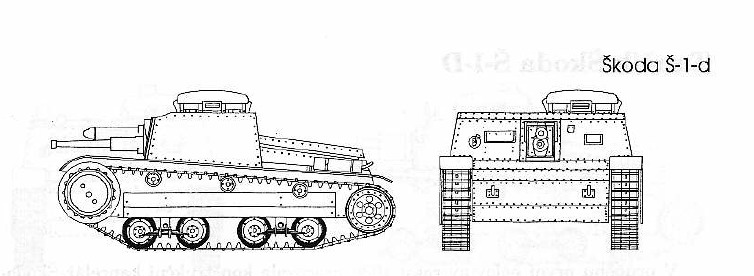
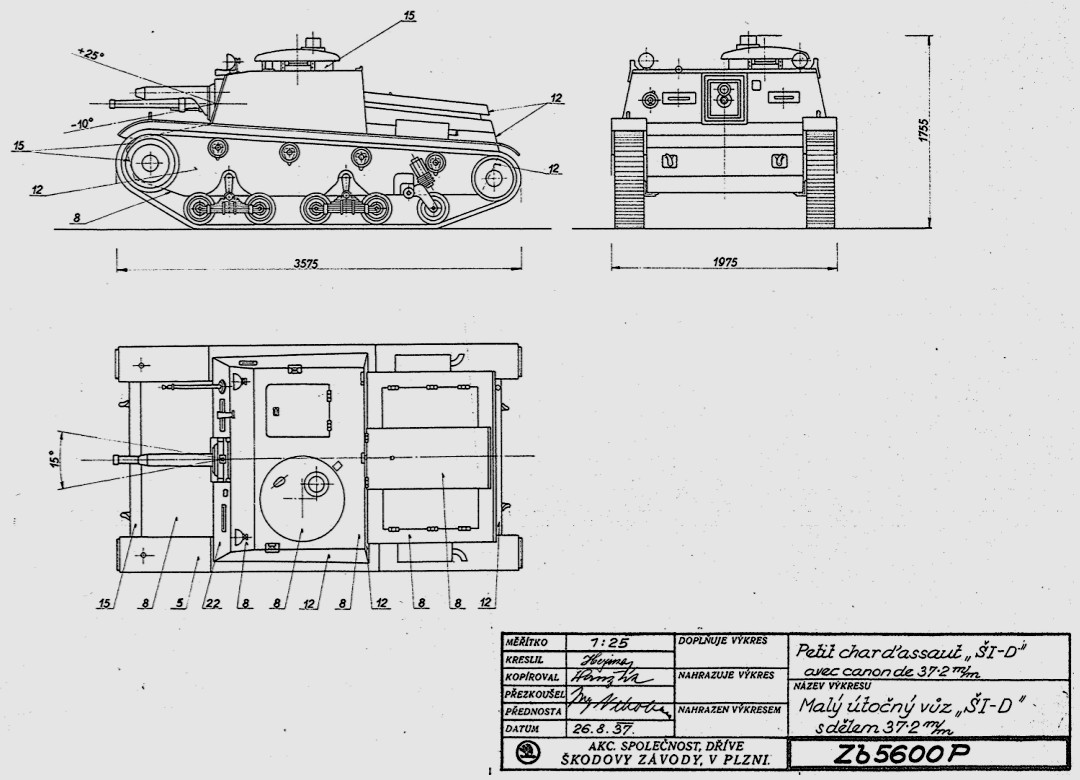
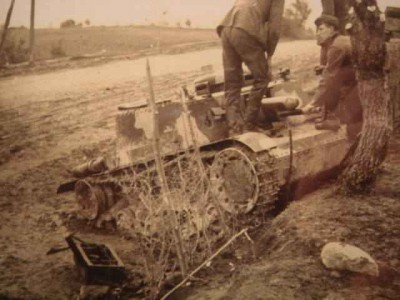
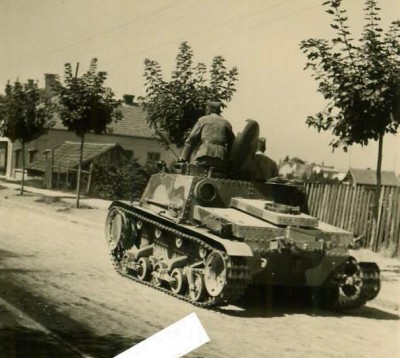
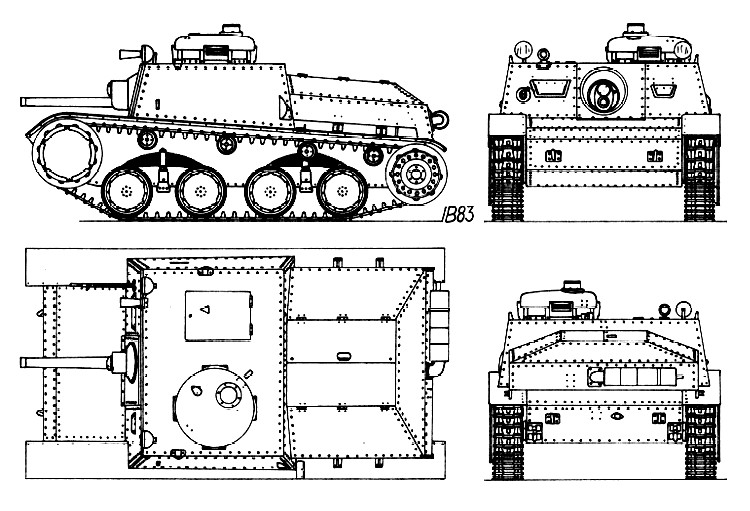

Funny little Cockroach…
What is the weird rocket-shaped device above/next to the gun on of these vehicles (And the Pz35/38?)
Gas brake.
Hydraulic recoil brake cylinder
Aaaah :-)
Thanks for enlightening me :-)
Yugomaniac has a proposal about the combining the Yugoslavian and Czech tech tree:
http://forum.worldoftanks.eu/index.php?/topic/312286-european-tree-national-branches-work-in-progress/
I think that’s a good idea. Anyway nice post, i’m waiting the Czech and Yugo tree (and all of the EU tree)
OFF:
Anyway, i know that the Czechs(and Slovaks) have bad memories about Hungary, but Hungary wasn’t fascist (at the time). A quote from the English Wikipedia:
“But in spite of their cooperation with the Nazi regime, Horthy and his government would be better described as “conservative authoritarian” than “fascist”. Certainly Horthy was as hostile to the home-grown fascist and ultra-nationalist movements which emerged in Hungary between the wars (particularly the Arrow Cross Party) as he was to Communism. The Arrow Cross leader, Ferenc Szálasi, was repeatedly imprisoned at Horthy’s command.”
I write just because you talked in plural.
Yes, I can confirm that. Hungary was not a Fascist-ruled country until the Germans put the Fascist leader Szálasi into power (it happened right after Horthy tried to quit the war and make a separate peace with the Allies).
Horthy was an old-fashioned Protestant aristocrat and he was disgusted by the Fascist, whom he considered a bunch of uneducated mob (along with the Communists), and he imprisoned many prominent members of both the Hungarian Fascist and Communist movements (including Szálasi himself). The country under Horthy was a somehow limited democracy with parties from the political left (social democrats) and right (Christian democrats), with continouos attempts to ban the Fascist and Communist parties of Hungary.
“Paternal autocrat” is a term I’ve seen used to describe that brand of would-be enlightened dictator with conservative leanings. Seems to have been relatively common breed at the time as most of the Central European specimen as well as Salazar and Franco apparently tend to get counted into the category.
And yeah, the Old Skool aristocratic sorts tended not be overly fond of rabble-rousing populists like the diverse Fascist-type movements. They typically seem to have considered the lot only marginally more palatable than outright revolutionary Communists,
Silentstalker: napadla mě jedna věc, určitě by šel jako ¨základní kanón použít kombinované dělo BA1/AB1 r.70/37 mm. Je trochu starší a pro začátek by to nabízelo použití buď protitankový kanón ¨nebo houfnici (s výměnou v garáži) a po zavedení víc děl na jednom tanku by je šlo použít zároveň (s přepínáním mezi AP a HE).
http://militera.lib.ru/tw/nikolaev_av/50.gif
http://forum.axishistory.com/download/file.php?id=170969&sid=99d7a0c92aa854cdb09a61cd00536b2d
Stejnou zbraní měl být vyzbrojený i tank KSÚ (Kombinovaný střední útočný vůz) – projekt z roku 1931:
http://utocnavozba.wz.cz/tank/s-siii.htm
Šlo, to bude v arty větvi.
Aha, ale to přece nevylučuje použití toho děla i u TD, s normálním zaměřovačem… Případně u tanku – třeba jako alternativní výzbroj kolohousenky :)
Ahhh, už asi žvaním z hladu – ale když už tam to dělo bude :D
“AT-1 I am your father”
“NOOOOOOOOOO”